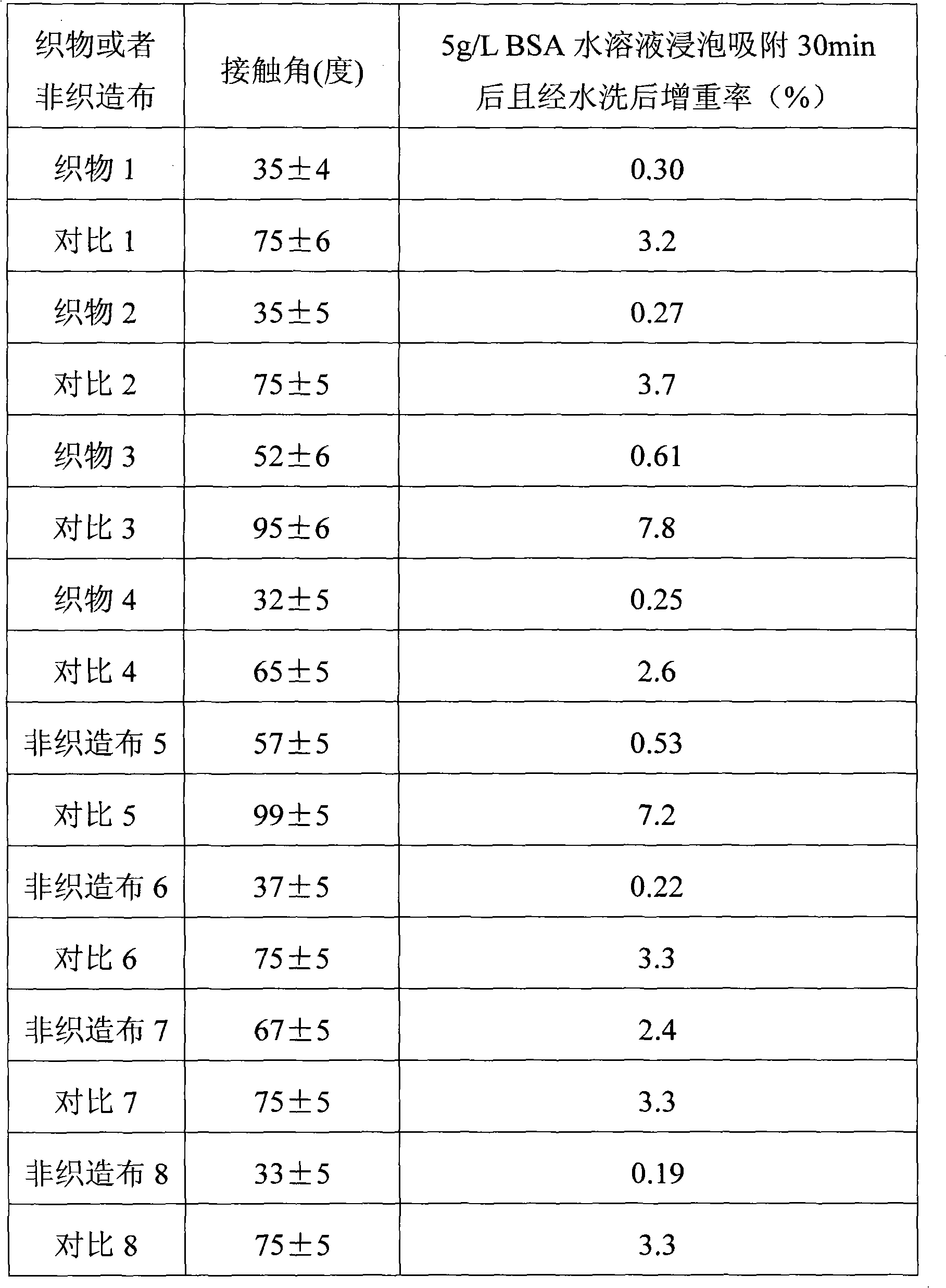Hydrophilic modification method of fabrics or nonwoven fabrics and obtained products
A non-woven fabric and hydrophilic technology, applied in the direction of textiles, papermaking, fiber treatment, etc., can solve the problems of complex operation and post-processing, long reaction time, high cost, etc., and achieve simple operation and post-processing, shorten post-processing The effect of time, significant economic benefits
- Summary
- Abstract
- Description
- Claims
- Application Information
AI Technical Summary
Problems solved by technology
Method used
Image
Examples
Embodiment 1
[0034] Embodiment 1 Hydrophilic modified PET fabric (fabric 1)
[0035] The hydrophobic PET (weight-average molecular weight=300,000) fabric was put into deionized water and boiled for 30 minutes to remove surface impurities, and then dried in a vacuum oven at 60 degrees Celsius to constant weight. The PET fabric is immersed in the aqueous solution containing 80% (w / w) ammonium persulfate and 1.6% (w / w) N, N'-methylenebisacrylamide until saturated adsorption; The aqueous solution was placed under a 300nm wavelength ultraviolet lamp and irradiated for 10 seconds, then taken out, washed with deionized water several times, and then tested.
[0036] The obtained hydrophilic modified PET fabric was tested for contact angle, and the surface of the fabric was smooth and hydrophilic. Anti-bovine serum albumin (BSA) contamination performance test results show that after 5g / L BSA aqueous solution is adsorbed for 30 minutes and then rinsed with deionized water, the PET fabric has a very...
Embodiment 2
[0039] Embodiment 2 hydrophilic modified nylon 66 fabric (fabric 2)
[0040] Put the nylon (weight-average molecular weight=250,000) fabric into deionized water and continue to boil for 30 minutes to remove surface impurities, and then dry it in a vacuum oven at 60 degrees Celsius to constant weight. Nylon fabric is soaked in the aqueous solution containing 15% (w / w) potassium hydrogen persulfate compound salt and 0.2% (w / w) cross-linking agent DE until saturated adsorption; The aforementioned aqueous solution soaked with nylon fabric is placed in After irradiating for 20 minutes under the ultraviolet lamp with a wavelength of 254nm, take it out and wash it with deionized water for several times before testing.
[0041] The prepared hydrophilic modified nylon fabric has a smooth surface and good hydrophilicity through a contact angle tester. Anti-bovine serum albumin (BSA) contamination performance test results show that after 5g / L of BSA aqueous solution is adsorbed for 30 m...
Embodiment 3
[0044] Embodiment 3 hydrophilic modified polypropylene fabric (fabric 3)
[0045] The hydrophobic polypropylene (weight-average molecular weight = 400,000) fabric was put into deionized water and boiled for 30 minutes to remove surface impurities, and then dried in a vacuum oven at 60 degrees Celsius to constant weight. The polypropylene fabric was soaked in a solution containing 10% (w / w) potassium hydrogen persulfate and 0.002% (w / w) trimethylolpropane tris-(3-ethyleneimino)-propionate and incubated at room temperature. In the aqueous solution of the coupling agent until saturated adsorption; the aforementioned aqueous solution soaked with polypropylene fabric is placed under a 254nm wavelength ultraviolet lamp for 30 seconds, then taken out and washed with deionized water for several times before testing.
[0046] The prepared hydrophilic modified polypropylene fabric has a smooth surface and good hydrophilicity through a contact angle tester. The test results of anti-BSA ...
PUM
| Property | Measurement | Unit |
|---|---|---|
| Wavelength | aaaaa | aaaaa |
Abstract
Description
Claims
Application Information
 Login to View More
Login to View More - R&D
- Intellectual Property
- Life Sciences
- Materials
- Tech Scout
- Unparalleled Data Quality
- Higher Quality Content
- 60% Fewer Hallucinations
Browse by: Latest US Patents, China's latest patents, Technical Efficacy Thesaurus, Application Domain, Technology Topic, Popular Technical Reports.
© 2025 PatSnap. All rights reserved.Legal|Privacy policy|Modern Slavery Act Transparency Statement|Sitemap|About US| Contact US: help@patsnap.com

